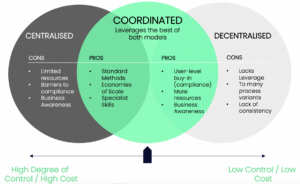The rise of cloud solutions and SaaS products has led to significant advancements in software integration and the availability of open-source data feeds. This growth has particularly impacted the discipline of Supplier, Supply Chain, and Third-Party Risk Management (TPRM). Managing the complex structure and data flow within a large organisation is challenging enough, but when you add the interaction with hundreds or thousands of external third parties on a daily basis, scalability becomes a critical problem to address in TPRM.
In today’s data-driven world, capturing valuable insight is one thing but establishing a smooth and efficient process to drive data insights and turn them into actions needs to be a key driver. You need the right team, an efficient operating model and clearly defined processes.
Here are some steps to put in place to make effective data-driven decisions:
1. Defining Ownership and Responsibilities: One of the fundamental aspects of an effective operating model is clearly defining ownership and responsibilities at each step of the process. This includes identifying the individuals responsible for managing the data, interpreting insights, and taking appropriate actions. An approach like the RACI model can help assign ownership and ensure accountability, even for automated processes. By establishing clear ownership, organisations can streamline operations and reduce the risk of bottlenecks or confusion.
2. Automation and Human Oversight: Automation plays a significant role in data processing and analysis. However, it is crucial to remember that automation still requires human oversight and responsibility. While leveraging platforms or SaaS solutions for automation, businesses should have internal operators who are accountable for managing and maintaining the automated processes. This human oversight ensures the reliability and integrity of the automation and allows for efficient scaling while minimising risks.

3. Centralised, Decentralised, or Hybrid Models: When designing an operating model, you must consider the type of organisational construct that suits their needs. There are three primary models: centralised, decentralised, and hybrid.
- Centralised Operating Model: Decision-making authority and control are concentrated at the top of the organisational hierarchy, allowing for standardisation and efficient coordination. It maximises control and quality but may face challenges in scalability.
- Decentralised Operating Model: Decision-making authority and control are distributed across different departments or teams, promoting quick decision-making and innovation. It allows for tailored approaches but can result in a lack of overall governance and inefficiencies.
- Hybrid Operating Model: It combines elements of centralisation and decentralisation, striking a balance between control and flexibility. Certain functions are centralised for standardisation, while others are decentralised to foster innovation and localised decision-making. It aims to achieve the best of both worlds.
A hybrid approach, when supported by high-quality guidance and digital tooling, will return over 99% of the benefit seen in both models with very few of the associated drawbacks.
Looking to strategically optimise your Customer-Supplier management operating model? Tune in to our Strategic thinking series as Nick Francis, CTMO of Brooklyn Solutions, underpins what needs to be considered to establish an efficient Customer-Supplier management operating model:
4. Assessing Team and Skills: Alongside the operating model, organizations must assess their teams and skills. The right team composition and skill sets are vital for successful implementation. Adequate training and upskilling initiatives should be in place to ensure that team members are equipped with the necessary expertise to handle data-driven decision-making. Organisations can drive better decision support and enhance response times by focusing on team and skills development.
In the journey from data to insights and insights to action, a strong operating model serves as the foundation for success. It provides clarity on ownership, ensures human oversight of automation, and helps organisations balance control and scalability. By considering organisational construct, team composition, and skills development, businesses can establish an operating model that drives efficient and effective data-driven decision-making. With a well-defined operating model in place, companies can harness the power of their data and achieve improved decision-making outcomes.
Discover how to turn your data into insight, and insight into action for your Third Party Risk and Supplier management by checking out the full whitepaper here.


